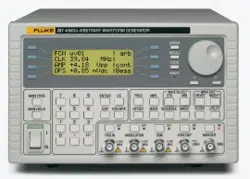Loading ...
Loading ...
Loading ...

Initial Operation
Principles of Operation 4
Thus for STANDARD FREQUENCY set to 1.000000000 MHz rotating the control
will change the frequency in 1 kHz steps. The display will autorange up or down as the
frequency is changed, provided that autoranging permits the increment size to be
maintained; this will in turn determine the lowest or highest setting that can be achieved
by turning the control. In the example above, the lowest frequency that can be set by
rotating the control is 1 kHz, shown on the display as 1
.000000000 kHz.
This is the limit because to show a lower frequency the display would need to autorange
below 1 kHz to x
xx.xxxxxx Hz, in which the most significant digit represents
100 Hz, i.e. the 1 kHz increment would be lost. If, however, the starting frequency had
been set to 1.0000
00000 MHz , i.e. a 100 Hz increment, the display would have
autoranged at 1 kHz to 9
00.0000000 Hz and could then be decremented further to
1
00.0000000 Hz without losing the 100 Hz increment.
Turning the control quickly will step numeric values in multiple increments.
Principles of Operation
The instrument operates in one of two different modes depending on the waveform
selected. Direct digital synthesis (DDS) mode is used for sine, cosine, haversine,
triangle, sin(x)/x and ramp waveforms. Clock synthesis mode is used for square, pulse,
pulse train, arbitrary and sequence.
In both modes the waveform data is stored in RAM. As the RAM address is incremented
the values are output sequentially to a digital-to-analogue converter (DAC) which
reconstructs the waveform as a series of voltage steps which are subsequently filtered
before being passed to the MAIN OUT connector.
shc0004f.emf
Figure 4-1. Single-Channel Simplified Block Diagram
The main differences between DDS and clock synthesis modes are the way in which the
addresses are generated for the RAM and the length of the waveform data.
Clock Synthesis Mode
In clock synthesis mode the addresses are always sequential (an increment of one) and
the clock rate is adjusted by the user in the range 100 MHz to 0·1 Hz. The frequency of
the waveform is the clock frequency divided by the waveform length, thus allowing short
waveforms to be played out at higher repetition rates than long waveforms.
For example the maximum frequency of an eight-point waveform is 100e6÷8 or
12.5 MHz, but a 1000-point waveform has a maximum frequency of 100e6÷1000 or
100 kHz.
shc0005f.emf
Figure 4-2. Clock Synthesis Mode
4-5
1.888.610.7664 sales@GlobalTestSupply.com
Fluke-Direct.com
Loading ...
Loading ...
Loading ...
